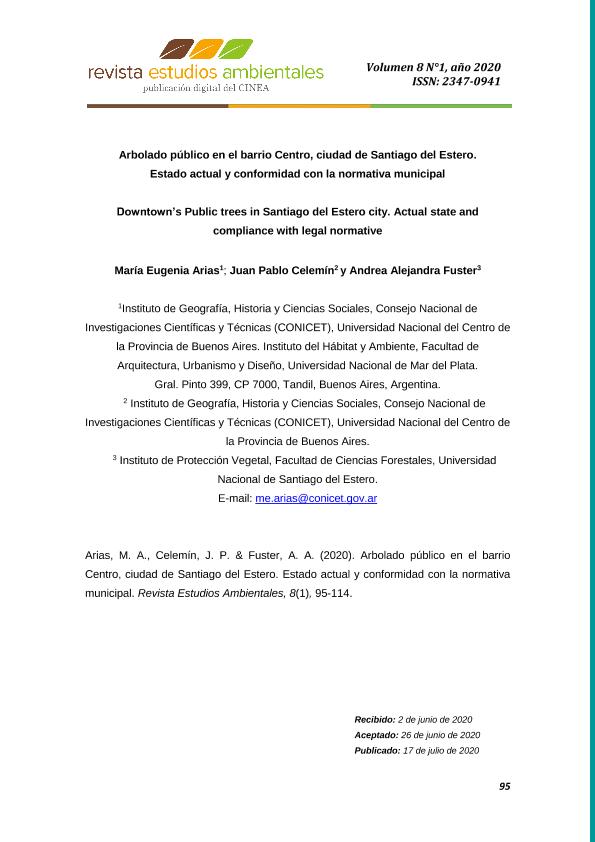Artículo
El arbolado es uno de los elementos más importantes en las ciudades, ya que los árboles forman parte integral del ambiente urbano y ofrecen numerosos beneficios ambientales, económicos, sociales y materiales. El objetivo de la investigación consistió, por un lado, en cotejar las plantaciones realizadas en el barrio Centro de la Ciudad de Santiago del Estero (Argentina) con la normativa vigente, y por el otro, establecer la cantidad de espacios verdes públicos y la superficie que ocupan. Para la primera parte del trabajo, se consideraron listas de especies botánicas sugeridas y no sugeridas por la ordenanza municipal. Se realizó un censo de vegetación considerando únicamente el arbolado de alineación del barrio Centro con un recorrido por sus 86 manzanas, durante los meses de verano del año 2019. Las especies vegetales censadas fueron identificadas hasta el nivel taxonómico de especie. Por su parte, las especies no sugeridas por la ordenanza fueron clasificadas según su origen biogeográfico y porte. El censo arrojó una abundancia de 3.125 ejemplares y una riqueza específica de 73 especies. De acuerdo al porte se reconocieron un mayor número de árboles, y por el origen se registraron mayor cantidad de especies exóticas. Además, se encontraron especies botánicas no recomendadas y recomendadas por la normativa. En relación a la segunda parte del trabajo, el barrio presentó un total de 11 espacios verdes públicos, los cuales representan el 1,87% de la superficie total siendo considerada una superficie insuficiente. De la cantidad de espacios verdes un mayor porcentaje lo ocupan plazas y un menor porcentaje lo constituyen plazoletas. Trees are one of the most important elements in cities, as trees are an integral part of the urban environment and offer numerous environmental, economic, social and material benefits. The objective of the research consisted, on one hand, in comparing the trees present in the Centro neighborhood of the City of Santiago del Estero (Argentina) with current regulations, and, on the other, establishing the amount of Public Green Spaces and the surface they occupy in the neighborhood. For the first part of the work, lists of botanical species suggested and not suggested by the municipal ordinance were considered. A vegetation census was carried out considering only the alignment trees of the Centro neighborhood consisting of 86 blocks, during the summer months of 2019. The trees were identified up to the taxonomic level of species. For their part, the species not suggested by the local ordinance were classified according to their biogeographical origin and size. The census showed an abundance of 3.125 specimens and a specific richness of 73 species. According to the size, a greater number of trees were recognized, and by origin, a greater number of exotic species were recorded. In addition, botanical species not recommended and recommended by regulations were found. In relation to the second part of the work, the neighborhood presented a total of 11 Public Green Spaces, which represent 1,87% of the total area which is considered insufficient. Of the amount of green spaces, a greater percentage is occupied by squares and a smaller percentage is made up of small squares.
Arbolado público en el barrio Centro, ciudad de Santiago del Estero: Estado actual y conformidad con la normativa municipal
Título:
Downtown’s Public trees in Santiago del Estero city: Actual state and compliance with legal normative
Fecha de publicación:
07/2020
Editorial:
Universidad Nacional del Centro de la Provincia de Buenos Aires. Facultad de Ciencias Humanas. Centro de Investigaciones y Estudios Ambientales
Revista:
Estudios Ambientales
e-ISSN:
2347-0941
Idioma:
Español
Tipo de recurso:
Artículo publicado
Clasificación temática:
Resumen
Archivos asociados
Licencia
Identificadores
Colecciones
Articulos(IGEHCS)
Articulos de INSTITUTO DE GEOGRAFIA, HISTORIA Y CS. SOCIALES
Articulos de INSTITUTO DE GEOGRAFIA, HISTORIA Y CS. SOCIALES
Citación
Arias, Maria Eugenia; Celemin, Juan Pablo; Fuster, Andrea Alejandra; Arbolado público en el barrio Centro, ciudad de Santiago del Estero: Estado actual y conformidad con la normativa municipal; Universidad Nacional del Centro de la Provincia de Buenos Aires. Facultad de Ciencias Humanas. Centro de Investigaciones y Estudios Ambientales; Estudios Ambientales; 8; 1; 7-2020; 95-114
Compartir




